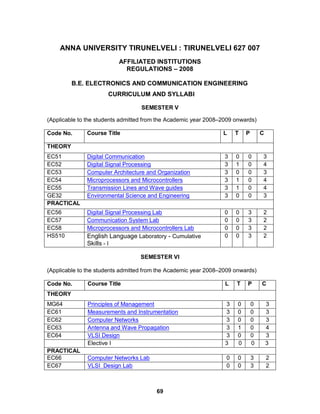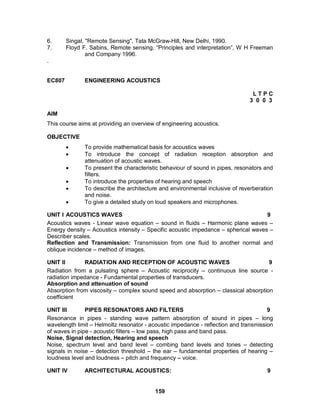This document provides course details for Electronics and Communication Engineering students regarding Digital Communication, Digital Signal Processing, Computer Architecture and Organization, Microprocessors and Microcontrollers, and Transmission Lines and Waveguides. It includes the course codes, titles, credits, objectives, topics covered and textbooks for each subject in semesters 5 and 6. Elective courses are also listed for semesters 6, 7 and 8.









































































![2. Intellectual Property Today : Volume 8, No. 5, May 2001, [www.iptoday.com].
3. Using the Internet for non-patent prior art searches, Derwent IP Matters, July
2000. [www.ipmatters.net/features/000707_gibbs.html.
GE606 PROFESSIONAL ETHICS IN ENGINEERING
L T PC
3 0 0 3
1. Engineering Ethics 9
Senses of ‘Engineering Ethics’ – Variety of moral issues – Types of inquiry – Moral
dilemmas – Moral Autonomy – Kohlberg’s theory – Gilligan’s theory – Consensus and
Controversy – Professions and Professionalism – Professional Ideals and Virtues –
Uses of Ethical Theories
2. Engineering as Social Experimentation 9
Engineering as Experimentation – Engineers as responsible Experimenters – Research
Ethics - Codes of Ethics – Industrial Standards - A Balanced Outlook on Law – The
Challenger Case Study
3. Engineer’s Responsibility for Safety 9
Safety and Risk – Assessment of Safety and Risk – Risk Benefit Analysis – Reducing
Risk – The Government Regulator’s Approach to Risk - Chernobyl Case Studies and
Bhopal
4. Responsibilities and Rights 9
Collegiality and Loyalty – Respect for Authority – Collective Bargaining – Confidentiality
– Conflicts of Interest – Occupational Crime – Professional Rights – Employee Rights –
Intellectual Property Rights (IPR) - Discrimination
5. Global Issues 9
Multinational Corporations – Business Ethics - Environmental Ethics – Computer Ethics -
Role in Technological Development – Weapons Development – Engineers as Managers
– Consulting Engineers – Engineers as Expert Witnesses and Advisors – Honesty –
Moral Leadership – Sample Code of Conduct
Total :45
Text Books :
1. Mike Martin and Roland Schinzinger, “Ethics in Engineering”, McGraw Hill, New York,
2005.
2. Charles E Harris, Michael S Pritchard and Michael J Rabins, “Engineering Ethics –
Concepts and Cases”, Thompson Learning, 2000.
142](https://image.slidesharecdn.com/ece-120616043559-phpapp01/85/Ece-74-320.jpg)


















